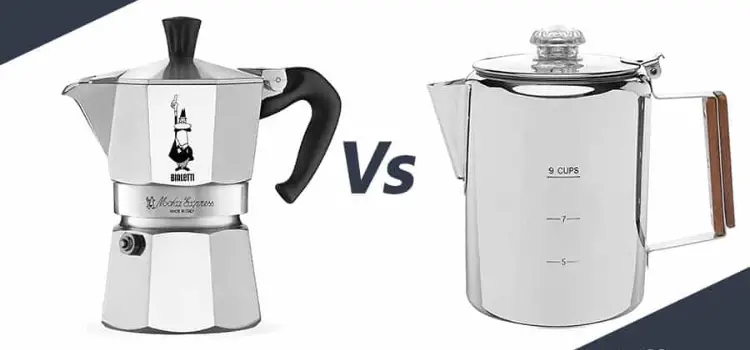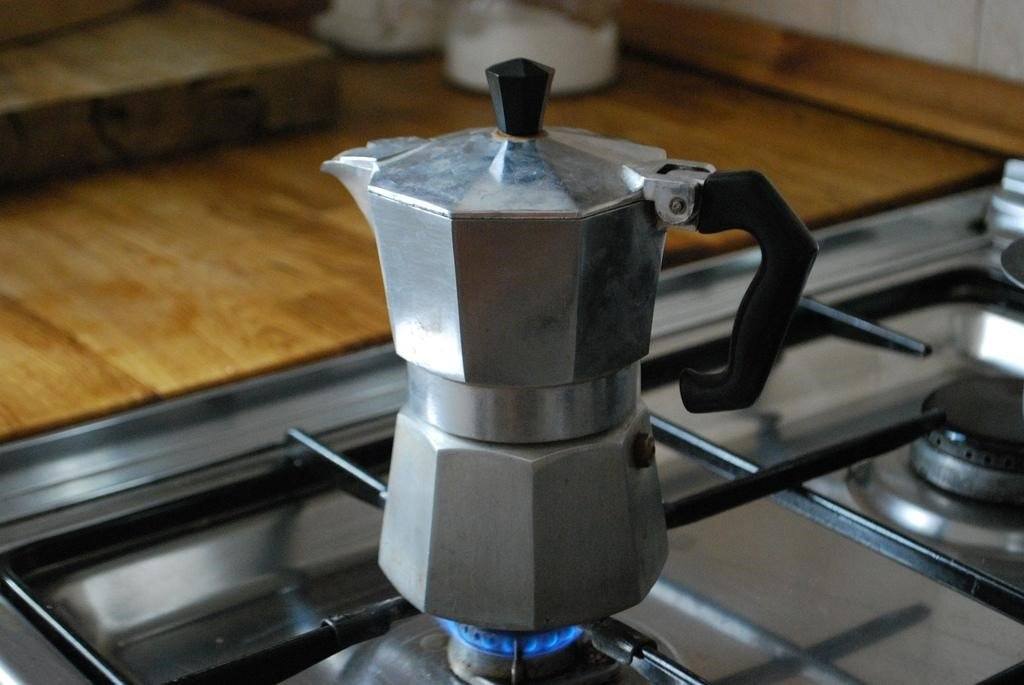As an Amazon Associate, I earn from qualifying purchases

A coffee percolator brews coffee by cycling water through grounds multiple times. In contrast, a Moka pot uses steam pressure to create a rich, espresso-like coffee.
Coffee enthusiasts often debate the merits of a coffee percolator versus a Moka pot. Each method offers distinct brewing styles, flavors, and experiences. A coffee percolator continuously brews by pushing hot water through coffee grounds, producing a robust cup. The Moka pot, on the other hand, brews coffee using steam pressure, resulting in a concentrated, rich flavor.
Both methods have loyal fans and unique characteristics that set them apart. Understanding the differences can help coffee lovers choose the best brewing method for their taste preferences and lifestyle. Explore the nuances of each to elevate your coffee experience.
Introduction To Brewing At Home
Brewing coffee at home has become a popular trend. Many people love the rich flavors and aromas. Two popular methods are the coffee percolator and the Moka pot. Each method offers a unique experience. Understanding both can help you enjoy coffee better.
The Rise Of Home Coffee Culture
More people want barista-quality coffee at home. This trend has grown in recent years. Several factors contribute to this rise:
- Convenience: Brew coffee anytime without leaving home.
- Cost-effective: Save money compared to coffee shops.
- Customization: Control the strength and flavors.
- Community: Share experiences with fellow coffee lovers.
Home brewing allows for creativity. Experiment with different beans and methods. Enjoy the satisfaction of making the perfect cup.
Choosing The Right Equipment
Picking the right brewing equipment is essential. Each method has its benefits and drawbacks. Here’s a quick comparison:
| Feature | Coffee Percolator | Moka Pot |
|---|---|---|
| Brewing Style | Continuous brewing cycle | Pressure brewing |
| Flavor Profile | Bold and strong | Rich and intense |
| Ease of Use | Simple to operate | Requires attention |
| Cleanup | Easy to clean | Requires more effort |
Consider your preferences and lifestyle. Do you want a quick brew? A percolator might be best. Want a strong, espresso-like coffee? The Moka pot is ideal.
Investing in quality equipment enhances your coffee experience. Choose wisely to enjoy every cup you brew.
The Coffee Percolator
The coffee percolator is a classic brewing device. It brews rich, bold coffee. This method has been popular for many years. Let’s explore its history and design, and see how it works.
History And Design
The coffee percolator dates back to the early 19th century. It was invented by a man named Hugh S. Hall in 1810. The design has evolved over time.
- Original design used a metal pot.
- Modern designs often use glass or stainless steel.
- It consists of two chambers: one for water and one for coffee grounds.
The percolator has a simple, yet effective design. Water heats up in the bottom chamber. As it boils, steam pressure forces water up a tube. The water then drips over the coffee grounds. This cycle repeats until the coffee reaches the desired strength.
How It Works
The percolation process is straightforward. Here’s how it works:
- Fill the bottom chamber with water.
- Add coffee grounds to the filter basket.
- Heat the pot on the stove or use an electric model.
- Watch as the water bubbles up.
- Enjoy your brewed coffee once it’s ready!
Percolators can brew several cups of coffee at once. They offer a unique flavor profile. Many coffee lovers appreciate this method.
| Feature | Percolator | Moka Pot |
|---|---|---|
| Brewing Time | 5-10 minutes | 3-5 minutes |
| Flavor Strength | Strong | Rich |
| Cups Brewed | Up to 12 cups | 2-6 cups |
Understanding the coffee percolator helps you appreciate its charm. It offers a different experience compared to other brewing methods.
The Moka Pot
The Moka Pot is a unique coffee maker. It brews coffee using steam pressure. This method creates a rich, strong brew. Many coffee lovers adore its taste and aroma.
Origin And Popularity
The Moka Pot originated in Italy in the 1930s. Designed by Alfonso Bialetti, it quickly gained popularity. Today, it remains a staple in many homes.
- Simple design
- Affordable price
- Rich coffee flavor
- Easy to use
Many people enjoy the Moka Pot for its charm. It brings a touch of Italy to the kitchen. Its classic design appeals to both young and old.
Operating Principles
The Moka Pot operates on a simple principle. It uses boiling water and steam pressure to brew coffee. Here’s how it works:
- Fill the bottom chamber with water.
- Place coffee grounds in the filter basket.
- As the water heats, steam forms.
- Pressure pushes water through the coffee grounds.
- The brewed coffee collects in the upper chamber.
| Component | Function |
|---|---|
| Bottom Chamber | Holds water and generates steam. |
| Filter Basket | Holds coffee grounds. |
| Upper Chamber | Collects brewed coffee. |
This method ensures a bold flavor. It stands out from other brewing methods. Many enjoy the intense aroma and taste.
Brewing Methods: Coffee Percolator Vs Moka Pot
Understanding the differences between a coffee percolator and a Moka pot enhances your coffee experience. Each brewing method offers unique characteristics. Let’s dive into the extraction process and flavor profiles.
Extraction Process
The extraction process varies significantly between these two methods. Here’s a quick overview:
| Method | Extraction Type | Brewing Time |
|---|---|---|
| Coffee Percolator | Continuous brewing | 8-10 minutes |
| Moka Pot | Pressure brewing | 4-5 minutes |
A coffee percolator cycles boiling water through coffee grounds. This process repeats until the desired strength is reached. It can lead to over-extraction if not monitored.
A Moka pot uses steam pressure to push water through coffee. This method extracts flavors quickly. It results in a stronger brew, often resembling espresso.
Flavor Profile Differences
The flavor profiles differ based on the brewing method used.
- Coffee Percolator: Tends to have a more robust taste.
- Moka Pot: Produces a rich, intense flavor with a thicker texture.
- Percolator: Can become bitter if brewed too long.
- Moka Pot: Offers a smooth, creamy finish.
- Preference: Choose based on your taste buds.
Both methods create unique coffee experiences. The choice depends on your desired flavor and brewing style.
Ease Of Use And Maintenance
Choosing between a coffee percolator and a Moka pot involves understanding their ease of use and maintenance. Each has unique features that affect your brewing experience.
Setting Up For The First Brew
Setting up both devices is simple. Here’s a quick guide:
| Device | Setup Steps |
|---|---|
| Coffee Percolator |
|
| Moka Pot |
|
Both devices are quick to set up. You can enjoy your coffee in no time.
Cleaning And Care
Cleaning is essential for great coffee. Here’s how to maintain both devices:
- Coffee Percolator:
- Unplug and let it cool.
- Disassemble the filter and basket.
- Wash with warm, soapy water.
- Rinse thoroughly to avoid soap residue.
- Moka Pot:
- Let it cool after use.
- Disassemble the top and bottom chambers.
- Rinse with hot water only.
- Avoid soap to preserve flavor.
Both devices require minimal effort for cleaning. Regular maintenance ensures they last longer.

Credit: www.javapresse.com
Durability And Design: Coffee Percolator Vs Moka Pot
Choosing between a coffee percolator and a moka pot involves understanding their durability and design. Both appliances have unique features that affect their lifespan and style.
Materials And Longevity
Material choice greatly impacts durability. Here’s a breakdown:
| Appliance | Materials | Expected Longevity |
|---|---|---|
| Coffee Percolator | Stainless steel, aluminum, glass | 5-10 years |
| Moka Pot | Aluminum, stainless steel | 5-15 years |
Stainless steel offers better resistance against rust. Aluminum is lighter but may not last as long. Both options can serve you well, depending on care.
Aesthetic Considerations
Design influences your kitchen’s look. Consider these points:
- Color: Coffee percolators come in various colors.
- Shape: Moka pots have a classic, elegant shape.
- Finish: Polished finishes shine in any setting.
Choose a design that matches your style. A well-designed appliance enhances your kitchen’s appeal.
Both options have unique aesthetics. Pick one that resonates with you.
Cost Considerations
Understanding the costs of a coffee percolator and a Moka pot is crucial. Both options have different price points and ongoing expenses. This section explores the initial investment and running costs for both brewing methods.
Initial Investment
The initial cost varies significantly between the two options.
| Type | Average Cost |
|---|---|
| Coffee Percolator | $20 – $100 |
| Moka Pot | $15 – $60 |
Coffee percolators tend to be pricier. Moka pots are generally more affordable. Quality influences the cost of both options.
Running Costs
Ongoing expenses also matter. These include maintenance and coffee supplies.
- Electricity: Percolators consume more energy.
- Gas: Moka pots use less energy when heated on the stove.
- Coffee Beans: Costs are similar for both methods.
Regular cleaning products add to the running costs. Moka pots require less maintenance, lowering expenses over time.
Personal Preferences And Conclusion
Choosing between a coffee percolator and a moka pot often depends on personal taste. Each method creates a unique coffee experience. Let’s explore how taste and ritual shape our choices.
Taste And Ritual
The flavor of coffee can vary greatly between brewing methods. Here’s a comparison:
| Brewing Method | Taste Profile | Brewing Ritual |
|---|---|---|
| Coffee Percolator | Bold, robust, often bitter | Requires monitoring; watch for bubbling |
| Moka Pot | Rich, espresso-like, smooth | Low-key; enjoy the brewing sound |
Coffee percolators brew by cycling water through coffee grounds. This method can extract strong flavors but may lead to bitterness. The brewing process involves active participation. Users must watch the pot closely.
Moka pots create coffee by using steam pressure. This method delivers a smooth and rich taste. The gentle bubbling sound adds charm to the ritual. It encourages a relaxed atmosphere.
Making The Choice
Choosing the right method depends on individual preferences. Here are some factors to consider:
- Flavor: Do you prefer bold or smooth coffee?
- Time: How much time can you dedicate to brewing?
- Experience: What kind of brewing ritual appeals to you?
- Convenience: How easy is it to use and clean?
Many people enjoy the coffee percolator for its strong flavor. Others prefer the moka pot for its unique taste and ease of use. Both methods offer a satisfying experience. Taste tests can help you decide your favorite.
Ultimately, both options provide a delightful coffee experience. Experimenting with both can lead to new discoveries.

Credit: cliffandpebble.com
Conclusion
Choosing between a coffee percolator vs a Moka pot depends on personal taste and brewing preference. Each method offers a unique flavor profile and experience. Consider your lifestyle and the type of coffee you enjoy most. Experimenting with both can lead to discovering your perfect cup of coffee.
Enjoy the journey!
Frequently Asked Questions
What Is The Difference Between Coffee Percolator Vs Moka Pot?
Percolators brew coffee by cycling boiling water, while moka pots create pressure to force water through coffee grounds.
Which Coffee Maker Brews Stronger Coffee?
Moka pots generally produce a stronger, richer flavor due to higher pressure extraction compared to percolators.
How Do You Clean A Percolator?
Disassemble the percolator, wash components with warm soapy water, and rinse thoroughly to remove any residue.
Can You Use The Same Coffee In Both?
Yes, but adjust the grind size. Moka pots require a finer grind, while percolators work well with coarser grounds.
As an Amazon Associate, I earn from qualifying purchases